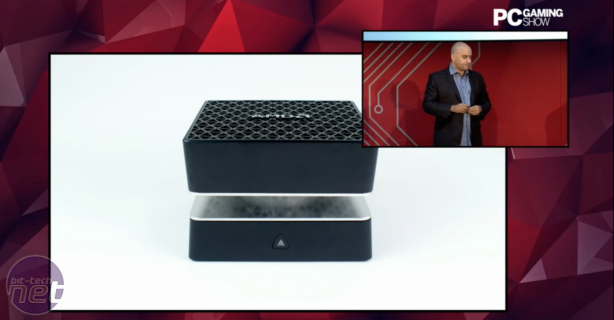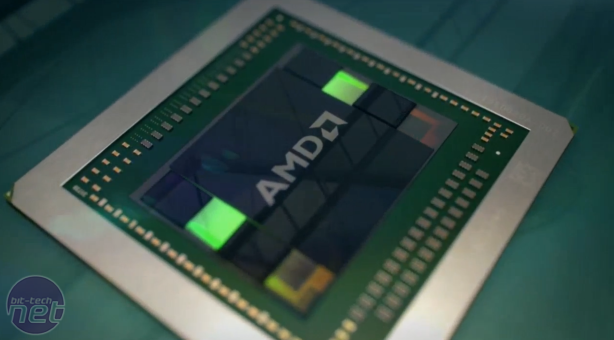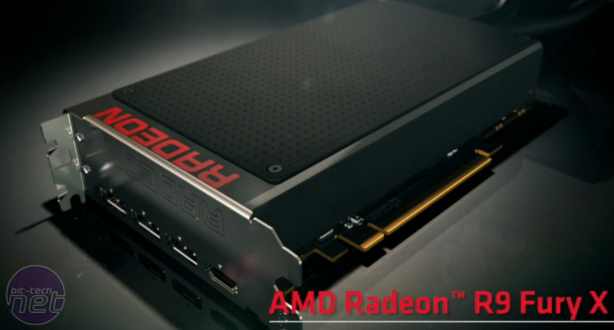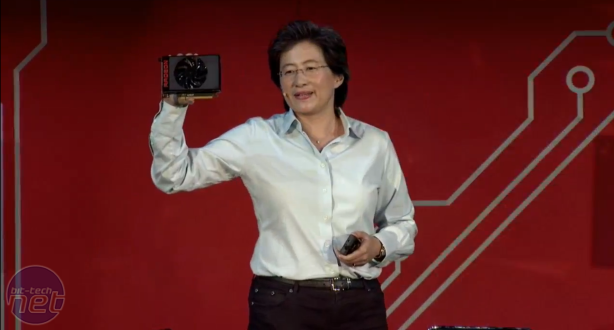
AMD has announced a slew of new graphics cards, including five Radeon R9 and R7 300 series parts and four cards based on its new Fiji GPU and high-bandwidth memory (HBM): the Radeon R9 Fury X, R9 Fury, R9 Nano and an as yet unnamed Fiji-based dual-GPU card.
Launched at an E3 livestream hosted by AMD Chief Gaming Scientist, Richard Huddy, the new graphics cards all include support for DirectX 12 (feature level not yet confirmed) and are based on AMD's Graphics Core Next architecture.
The major announcement, of course, is the quartet of Fiji-based cards, since these utilise a brand new GPU and are the first in the world to feature high-bandwidth memory, the successor to GDDR5 (read our overview of HBM and what it means here). First up, we have the liquid-cooled Radeon R9 Fury X, the new flagship single GPU card. The Fiji GPU inside is a scaled-up version of Hawaii, the GPU that powers the R9 290 series. It sports 4,096 stream processors, almost 1.5x as many as the R9 290X, and can deliver 8.6 TFLOPS of power using a staggering 8.9 billion transistors. AMD has worked on its reference design too; Fury X will have a black-nickel aluminium exoskeleton, soft-touch aluminium plates and LED illumination.
Now, Hawaii cards have become well known for their high power consumption and heat output, so scaling upwards like this may seem insane. However, AMD says it has addressed efficiency through tweaks to the GCN architecture, power management algorithms and board design (e.g. voltage regulators). HBM is also a more power and space efficient solution than GDDR5. Ultimately, AMD says Fiji delivers around 1.5x the performance per watt of the R9 290X. Power figures were only glossed over, but AMD said it has used a 500W liquid-cooling solution for Fury X, but the card itself typically consumes around 275W. It also claims that this extra headroom will be very beneficial to overclockers. The Fury X is launching next week on June 24th with an MSRP of $649 USD. This is the same launch price as the GTX 980 Ti, so performance is likely to be similar. Stay tuned for the full review next week.
Next is the Radeon R9 Fury, which is presumably a slightly cut down version of the Fury X. On stage, it was said to be an air-cooled card, though a press release on the new cards says a liquid-cooled model will be available too. Either way, it's launching on July 14th for $549 USD.
AMD also had a few surprises, including a dinky Fiji-based card. Measuring just 6-inches long and in a dual-slot frame, the R9 Nano is seriously cute and promises twice the performance per watt of the R9 290X, and more raw performance too. Its availability is loosely scheduled for later this summer.
The last Fiji announcement was a dual-GPU one. This card will launch in autumn this year and is said to deliver the fastest graphics performance in the world. AMD also had on show a concept PC called Project Quantum, which uses a dual Fiji GPU solution that's liquid-cooled and in a living room-friendly sized chassis. AMD is targetting 4K living room gaming with this – it is thus likely to compete with Corsair's Bulldog PC, which was announced at Computex 2015.

Click to enlarge - The Project Quantum PC, with the hardware in the bottom section and liquid cooling in the top one
Also announced were new cards to make up the R9 300 and R7 300 series of cards, which are launching properly in two days on June 18. Specifications were not revealed; these are all expected to be tweaks or rebrands of existing R9 200 series parts, although we do know that all of the R9 300 series parts will support FreeSync. From top to bottom, the range includes the R9 390X for $429 USD followed by the R9 390 for $329. Both of these cards will have 8GB of GDDR5. Next is the R9 380 for $199 (up to 4GB of GDDR5), the R7 370 for $149 and finally the R7 360 for $109. This is at least a much more streamlined lineup than the current R9 200 series, which has multiple SKUs at or around the same price point.
Launched at an E3 livestream hosted by AMD Chief Gaming Scientist, Richard Huddy, the new graphics cards all include support for DirectX 12 (feature level not yet confirmed) and are based on AMD's Graphics Core Next architecture.
The major announcement, of course, is the quartet of Fiji-based cards, since these utilise a brand new GPU and are the first in the world to feature high-bandwidth memory, the successor to GDDR5 (read our overview of HBM and what it means here). First up, we have the liquid-cooled Radeon R9 Fury X, the new flagship single GPU card. The Fiji GPU inside is a scaled-up version of Hawaii, the GPU that powers the R9 290 series. It sports 4,096 stream processors, almost 1.5x as many as the R9 290X, and can deliver 8.6 TFLOPS of power using a staggering 8.9 billion transistors. AMD has worked on its reference design too; Fury X will have a black-nickel aluminium exoskeleton, soft-touch aluminium plates and LED illumination.
Now, Hawaii cards have become well known for their high power consumption and heat output, so scaling upwards like this may seem insane. However, AMD says it has addressed efficiency through tweaks to the GCN architecture, power management algorithms and board design (e.g. voltage regulators). HBM is also a more power and space efficient solution than GDDR5. Ultimately, AMD says Fiji delivers around 1.5x the performance per watt of the R9 290X. Power figures were only glossed over, but AMD said it has used a 500W liquid-cooling solution for Fury X, but the card itself typically consumes around 275W. It also claims that this extra headroom will be very beneficial to overclockers. The Fury X is launching next week on June 24th with an MSRP of $649 USD. This is the same launch price as the GTX 980 Ti, so performance is likely to be similar. Stay tuned for the full review next week.
Next is the Radeon R9 Fury, which is presumably a slightly cut down version of the Fury X. On stage, it was said to be an air-cooled card, though a press release on the new cards says a liquid-cooled model will be available too. Either way, it's launching on July 14th for $549 USD.
AMD also had a few surprises, including a dinky Fiji-based card. Measuring just 6-inches long and in a dual-slot frame, the R9 Nano is seriously cute and promises twice the performance per watt of the R9 290X, and more raw performance too. Its availability is loosely scheduled for later this summer.
The last Fiji announcement was a dual-GPU one. This card will launch in autumn this year and is said to deliver the fastest graphics performance in the world. AMD also had on show a concept PC called Project Quantum, which uses a dual Fiji GPU solution that's liquid-cooled and in a living room-friendly sized chassis. AMD is targetting 4K living room gaming with this – it is thus likely to compete with Corsair's Bulldog PC, which was announced at Computex 2015.

Click to enlarge - The Project Quantum PC, with the hardware in the bottom section and liquid cooling in the top one
Also announced were new cards to make up the R9 300 and R7 300 series of cards, which are launching properly in two days on June 18. Specifications were not revealed; these are all expected to be tweaks or rebrands of existing R9 200 series parts, although we do know that all of the R9 300 series parts will support FreeSync. From top to bottom, the range includes the R9 390X for $429 USD followed by the R9 390 for $329. Both of these cards will have 8GB of GDDR5. Next is the R9 380 for $199 (up to 4GB of GDDR5), the R7 370 for $149 and finally the R7 360 for $109. This is at least a much more streamlined lineup than the current R9 200 series, which has multiple SKUs at or around the same price point.

MSI MPG Velox 100R Chassis Review
October 14 2021 | 15:04












Want to comment? Please log in.